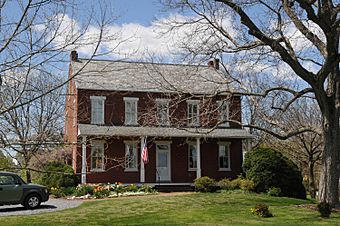Christian Habeck Farm facts for kids
Quick facts for kids |
|
|
Christian Habeck Farm
|
|

Farmhouse
|
|
| Location | 2301 Spring Valley Rd., East Hempfield Township, Pennsylvania |
|---|---|
| Area | 90.4 acres (36.6 ha) |
| Built | 1869 |
| Architectural style | Pennsylvania-style farmhouse |
| MPS | Historic Farming Resources of Lancaster County MPS |
| NRHP reference No. | 94001063 |
| Added to NRHP | August 30, 1994 |
The Christian Habeck Farm, also known as the Abraham Brubaker Farm, is a really old and important farm. It's located in East Hempfield Township, Lancaster County, Pennsylvania. This farm is special because it's a "historic district." This means it's a place with many old buildings that tell a story about the past. It was added to a special list of historic places in 1994.
Contents
What is the Christian Habeck Farm?
The Christian Habeck Farm is more than just one building. It's a whole collection of 12 important buildings that have been around for a long time. These buildings help us understand what farm life was like many years ago in Pennsylvania. The farm covers about 90 acres, which is like 68 football fields!
Exploring the Farm Buildings
Imagine stepping back in time to see how a farm worked over a hundred years ago. The Christian Habeck Farm has many buildings that were essential for daily life and work.
The Main Farmhouse
The main house on the farm is a large, two-and-a-half-story building made of brick. It was built in the mid-to-late 1800s. It has a big porch across the front. This is where the farm family lived and gathered.
Other Important Buildings
Besides the main house, there are many other cool buildings on the farm:
- A large wooden bank barn built in 1869. A bank barn is special because it's built into a hillside, so you can enter different levels from the ground.
- A spring house from around 1876. This building was used to keep food cool using natural spring water.
- Two wooden tobacco barns from about 1920. These were used to dry tobacco leaves after they were harvested.
- A brick tenant house from around 1880. This was likely where farm workers or another family lived.
- A summer kitchen from about 1876. In the old days, people often cooked in a separate building during hot summers to keep the main house cool.
- A pigsty from around 1900, where pigs were kept.
- A milk house, used for storing milk.
- A creamery from about 1910, where cream was separated from milk.
Each of these buildings played a vital role in the farm's daily operations. They show us how people lived and worked on a farm in the past.
Why is it Historic?
The Christian Habeck Farm was added to the National Register of Historic Places in 1994. This is a special list kept by the United States government. When a place is on this list, it means it's important to the history of the country, state, or local community. It helps protect these places so future generations can learn from them. The farm is a great example of a Pennsylvania-style farm from the 19th century.



